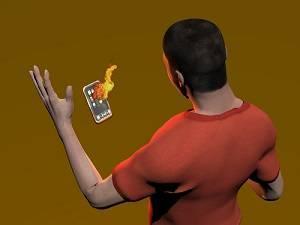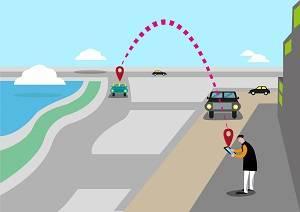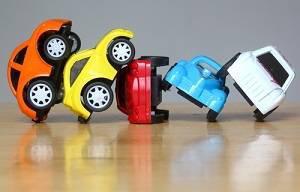
 In several recent posts on this blog, we discussed some of the dangers associated with cell phone use while driving. Texting, checking emails, and even just talking—hands-free or not—can lead to serious accidents and severe injuries. Sometimes, however, a cell phone can be the source of danger, even when it is nowhere near a moving car. Sometimes, the phone itself is defective and can cause damage and injuries to its user. It is exactly this type of situation that has led to a massive recall by one of the world’s leading cell phone manufacturers, the fallout of which has been felt around the globe.
In several recent posts on this blog, we discussed some of the dangers associated with cell phone use while driving. Texting, checking emails, and even just talking—hands-free or not—can lead to serious accidents and severe injuries. Sometimes, however, a cell phone can be the source of danger, even when it is nowhere near a moving car. Sometimes, the phone itself is defective and can cause damage and injuries to its user. It is exactly this type of situation that has led to a massive recall by one of the world’s leading cell phone manufacturers, the fallout of which has been felt around the globe.
Samsung Recalls More Than Two Million Phones
South Korean electronics giant Samsung announced last month that it was recalling some 2.5 million units of its high-end flagship smartphone, the Galaxy Note 7. The phone had only been on the market for less than a month when users first began reporting incidents of overheating. Some phones even caught fire and exploded. The problems were initially blamed on a particular type of battery being used in the production process, and replacement phones were given to affected customers. Then, the replacements allegedly started exploding and catching fire too.
 It is becoming increasingly apparent that a growing number of people now prefer their social media over their own safety. While people are falling over cliff faces taking selfies, drivers on our nation’s busy highways are still failing to pay the proper attention required behind the wheel. Thousands of accidents occur every day due to driver error and, more specifically, driver distraction. If you have been involved in a car accident and suspect that the other driver was texting and driving, you may be entitled to compensation for the injuries you have suffered, helping you get on the road to recovery.
It is becoming increasingly apparent that a growing number of people now prefer their social media over their own safety. While people are falling over cliff faces taking selfies, drivers on our nation’s busy highways are still failing to pay the proper attention required behind the wheel. Thousands of accidents occur every day due to driver error and, more specifically, driver distraction. If you have been involved in a car accident and suspect that the other driver was texting and driving, you may be entitled to compensation for the injuries you have suffered, helping you get on the road to recovery.
Distracted Drivers: A Continuing Epidemic
While they may be wonderful tools to stay connected, our mobile devices come with their downsides. One such disadvantage is that to use such a device, you must be essentially face-down looking at screen. Cell phones are obviously extremely useful when it comes to navigating city streets and routes for your errands and road trips, but the habit of texting while behind the wheel is extremely dangerous. Young people, especially, are prone to this and are often also the victims when a serious crash occurs and someone is injured.
 Planning for a hospital stay can be a very anxious time under the best of circumstances. Not fully understanding your rights while under the care of the hospital, however, may lead to additional medical issues giving way to a possible hospital malpractice lawsuit.
Planning for a hospital stay can be a very anxious time under the best of circumstances. Not fully understanding your rights while under the care of the hospital, however, may lead to additional medical issues giving way to a possible hospital malpractice lawsuit.
Establishing Patient Rights
In 1973, the American Hospital Association’s House of Delegates implemented the Patient’s Bill of Rights as a measure to not only protect the patient but also medical providers as well. The guidelines were designed to encourage effective health care by strengthening the collaboration between patients and their medical team. They were also employed to open lines of honest communication and to elevate levels of respect between both patients and medical professionals.
The list also holds responsible the medical team responsible for ensuring the ethical treatment of all patients. In addition, the Patient’s Bill of Rights specifies that all medical professionals be sensitive to patients of varying cultural, racial, linguistic, religious beliefs, age, gender, and disability.
 When a person is injured on the job, he or she should not return to work until he or she has recovered enough to do so. In some cases, such healing may only take a few days, while, in others, physical recovery may require weeks, months, or even years. According to Illinois law, injured employees who miss time at work are eligible to collect temporary disability as part of a workers’ compensation benefits package. Recent studies suggest, however, that injured workers in Illinois miss about 50 percent more work, on average, than injured workers in Indiana, Iowa, and Wisconsin.
When a person is injured on the job, he or she should not return to work until he or she has recovered enough to do so. In some cases, such healing may only take a few days, while, in others, physical recovery may require weeks, months, or even years. According to Illinois law, injured employees who miss time at work are eligible to collect temporary disability as part of a workers’ compensation benefits package. Recent studies suggest, however, that injured workers in Illinois miss about 50 percent more work, on average, than injured workers in Indiana, Iowa, and Wisconsin.
Wide Disparity
The average length of a temporary disability claim in Illinois is 18.4 weeks, according to the 2015 annual report issued by the Illinois Workers’ Compensation Commission. By comparison, injured workers in Indiana missed an average of 10.5 weeks, 10.9 weeks in Wisconsin, and 11.6 weeks in Iowa. In Michigan, an average claim for temporary disability lasted approximately 15.7 weeks, the second-highest in the region. Some of the disparity in the amount time missed can be attributed to types of work found in each state. The balance of manufacturing, office, farming, service industry, and public sector jobs can all have an impact on the types and severity of sustained injuries.
 Pacemakers are common medical devices used in people of all ages, from children to elderly adults. They are a useful and lifesaving tool used to regulate a heartbeat in someone whose own body is unable to do so. As with any device, there is required maintenance and properly suggested usage to extend the life of the product. Even still, there occasionally some products are defectively manufactured, which can be life-threatening.
Pacemakers are common medical devices used in people of all ages, from children to elderly adults. They are a useful and lifesaving tool used to regulate a heartbeat in someone whose own body is unable to do so. As with any device, there is required maintenance and properly suggested usage to extend the life of the product. Even still, there occasionally some products are defectively manufactured, which can be life-threatening.
Why Do People Use Pacemakers?
Pacemakers are extremely useful for a variety of reasons. The most common of these reasons are for arrhythmias (irregular heartbeats) and heart blocks (caused by a sudden disruption of the impulses to the heart, such as a heart attack). Other reasons your physician may prescribe a pacemaker are:
 All across the country, ridesharing programs have made getting from one place to another simpler, easier, and more affordable. Unfortunately, there have also been auto accidents involving Uber, Lyft, Sidecar, and other rideshare drivers. Who is responsible when this happens? Can a victim pursue compensation for their injuries? The following can help you better understand this complex area of the law, and how it may apply to your particular situation.
All across the country, ridesharing programs have made getting from one place to another simpler, easier, and more affordable. Unfortunately, there have also been auto accidents involving Uber, Lyft, Sidecar, and other rideshare drivers. Who is responsible when this happens? Can a victim pursue compensation for their injuries? The following can help you better understand this complex area of the law, and how it may apply to your particular situation.
Driver vs. Rideshare Company – Who is Really Liable?
In the beginning, victims injured by Uber and other rideshare drivers faced serious problems in pursuing their claims. This was often because, rather than being employees of the company, rideshare drivers were (and still are) considered independent contractors and, essentially, sole proprietors of their own companies. So, if someone was injured by an Uber driver, the driver’s insurance was generally considered the primary. If the driver had inadequate insurance, then victims were often left with little to no compensation. Rideshare companies themselves rarely stepped in, but even when they did, they carried so low of a policy that victims found little relief.
 Giving birth is both one of the most common and one of the most dangerous procedures performed by a medical professional. Both mother and child (or children) can sustain injury if even a small mistake is made, and many such injuries will occur due to what is referred to as shoulder dystocia. This condition is a primary concern for obstetricians during delivery.
Giving birth is both one of the most common and one of the most dangerous procedures performed by a medical professional. Both mother and child (or children) can sustain injury if even a small mistake is made, and many such injuries will occur due to what is referred to as shoulder dystocia. This condition is a primary concern for obstetricians during delivery.
Facts and Statistics
Shoulder dystocia is defined as a condition in which a newborn’s shoulder becomes lodged behind the pubic bone or in another spot in the birth canal and cannot be freed without either significant manipulation or cesarean section. It can cause multiple birth injuries in a newborn, including cerebral palsy and other nerve injuries, as well as internal bleeding and post-delivery complications for the mother.
In terms of general numbers of cases in comparison to the total number of births in any given year, the incidence of shoulder dystocia is low, only affecting a number between 0.6 and 1.4 percent of average-sized infants (weighing roughly between 5 and 8 pounds). However, the rate does rise as high as 9 percent for infants weighing more than 8 pounds, 13 ounces. The single most critical risk factor for shoulder dystocia is the use of an aid in delivery, such as a forceps or vacuum extractor. Generally, such tools are too imprecise to give the obstetrician enough control to guide the newborn through the birth canal without becoming stuck.
 Auto accident injuries are frightening and alarming for anyone to experience or witness. However, young children are especially prone to catastrophic injuries, partly because their size and developing bodies make them more prone to certain injuries, but also because young children are unable to communicate when or where something hurts. Even more alarming is that some injuries cannot be seen, and parents may unwittingly make the wrong decision after an accident. Atlanto-occipital dislocation, or internal decapitation, is one such injury.
Auto accident injuries are frightening and alarming for anyone to experience or witness. However, young children are especially prone to catastrophic injuries, partly because their size and developing bodies make them more prone to certain injuries, but also because young children are unable to communicate when or where something hurts. Even more alarming is that some injuries cannot be seen, and parents may unwittingly make the wrong decision after an accident. Atlanto-occipital dislocation, or internal decapitation, is one such injury.
Internal Decapitation – What is It?
Internal decapitation is not an actual decapitation. In fact, the neck itself often appears to be intact. However, beneath the intact flesh, neck ligaments may have been severed or stretched. If not handled correctly and treated immediately, the lower part of the brain stem – a vital part of the brain that controls breathing – can be damaged and ultimately lead to death. The only chance at survival is the complete and careful stabilization of the neck and head. But even then, survival is not guaranteed, and the risk of permanent paralysis is extremely high.
 When you have been injured on the job, your first source of relief—after addressing your physical injuries—is usually provided by benefits offered through workers’ compensation. Workers’ compensation benefits typically offer coverage for medical expenses, temporary or permanent disability, and some recompense for lost wages. Because the law in Illinois requires employers to provide workers’ compensation for their employees, many workers simply take the system for granted. They give little thought to the reality that workers’ compensation is a type of insurance policy that the employer must purchase at the expense of the company.
When you have been injured on the job, your first source of relief—after addressing your physical injuries—is usually provided by benefits offered through workers’ compensation. Workers’ compensation benefits typically offer coverage for medical expenses, temporary or permanent disability, and some recompense for lost wages. Because the law in Illinois requires employers to provide workers’ compensation for their employees, many workers simply take the system for granted. They give little thought to the reality that workers’ compensation is a type of insurance policy that the employer must purchase at the expense of the company.
High Expenses, Even for Safe Workers
In recent years, the growing costs of purchasing workers’ compensation in Illinois has led many business owners to question the sustainability of the current system. The neighboring states of Missouri and Indiana manage to offer comprehensive workers’ compensation benefits with a significantly lower price tag. One business leader, whose company offers trucking services, said that if he moved his 17 trucking jobs to Missouri, his company could save more than $25,000 annually, just on workers’ compensation costs. He could reportedly save $66,000 on the insurance by moving to Indiana. “We’re just a victim of a high-priced system,” the company president said.
 Recently, a new federal law went into effect that requires automobile rental companies to fix any vehicles on their lots that have been recalled. The drafting and passage of the law were largely byproducts of the tragic deaths of Raechel and Jacqueline Houck, who were killed when their recalled rental car malfunctioned due to the company’s failure to repair it.
Recently, a new federal law went into effect that requires automobile rental companies to fix any vehicles on their lots that have been recalled. The drafting and passage of the law were largely byproducts of the tragic deaths of Raechel and Jacqueline Houck, who were killed when their recalled rental car malfunctioned due to the company’s failure to repair it.
The Dangers of Renting Recalled Vehicles
In 2004, the auto manufacturer Chrysler notified Enterprise Rental Company that one of their models—the PT Cruiser—had a faulty power steering hose that needed to be replaced. However, rather than placing the car on the inventory list until repairs could be completed, the company continued to rent the vehicle. Tragically, the failure to replace the defective hose caused a loss of steering and a subsequent fire, which led to the untimely deaths of the Houck sisters.